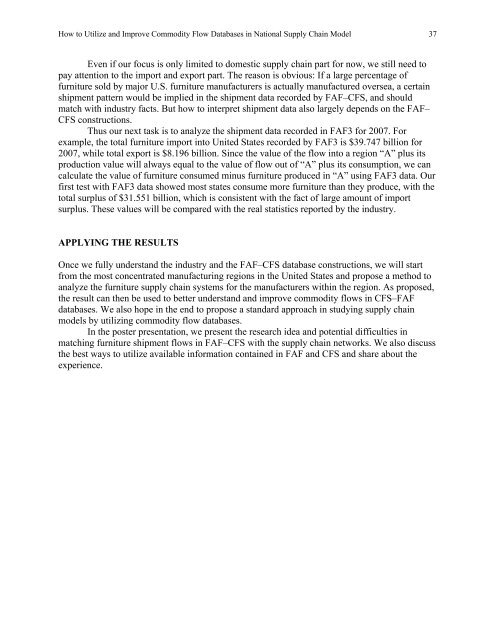E-C158 Cover1 - Center for Transportation Analysis - Oak Ridge ...
E-C158 Cover1 - Center for Transportation Analysis - Oak Ridge ...
E-C158 Cover1 - Center for Transportation Analysis - Oak Ridge ...
Create successful ePaper yourself
Turn your PDF publications into a flip-book with our unique Google optimized e-Paper software.
How to Utilize and Improve Commodity Flow Databases in National Supply Chain Model 37<br />
Even if our focus is only limited to domestic supply chain part <strong>for</strong> now, we still need to<br />
pay attention to the import and export part. The reason is obvious: If a large percentage of<br />
furniture sold by major U.S. furniture manufacturers is actually manufactured oversea, a certain<br />
shipment pattern would be implied in the shipment data recorded by FAF–CFS, and should<br />
match with industry facts. But how to interpret shipment data also largely depends on the FAF–<br />
CFS constructions.<br />
Thus our next task is to analyze the shipment data recorded in FAF3 <strong>for</strong> 2007. For<br />
example, the total furniture import into United States recorded by FAF3 is $39.747 billion <strong>for</strong><br />
2007, while total export is $8.196 billion. Since the value of the flow into a region “A” plus its<br />
production value will always equal to the value of flow out of “A” plus its consumption, we can<br />
calculate the value of furniture consumed minus furniture produced in “A” using FAF3 data. Our<br />
first test with FAF3 data showed most states consume more furniture than they produce, with the<br />
total surplus of $31.551 billion, which is consistent with the fact of large amount of import<br />
surplus. These values will be compared with the real statistics reported by the industry.<br />
APPLYING THE RESULTS<br />
Once we fully understand the industry and the FAF–CFS database constructions, we will start<br />
from the most concentrated manufacturing regions in the United States and propose a method to<br />
analyze the furniture supply chain systems <strong>for</strong> the manufacturers within the region. As proposed,<br />
the result can then be used to better understand and improve commodity flows in CFS–FAF<br />
databases. We also hope in the end to propose a standard approach in studying supply chain<br />
models by utilizing commodity flow databases.<br />
In the poster presentation, we present the research idea and potential difficulties in<br />
matching furniture shipment flows in FAF–CFS with the supply chain networks. We also discuss<br />
the best ways to utilize available in<strong>for</strong>mation contained in FAF and CFS and share about the<br />
experience.

















